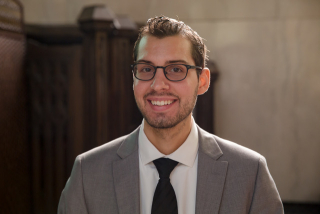Two doctoral students, Adam Wills Begley (DMus ’21) and Nicholas Capozzoli (DMus ’20) have won this year’s Dean’s Essay Prize. Read more about exciting projects and backgrounds below.
Adam Wills Begley (first prize)

A prolific ensemble singer and soloist, Adam was a member of the Grammy Award-winning University of Michigan Chamber Choir and Choral Scholar at St. Martin-in-the-Fields, London. Adam began his training at Yale University, where he served as Music Director of the vocal jazz group Redhot & Blue. As Assistant Conductor of the Yale Whiffenpoofs, America’s oldest collegiate a cappella group, Adam led performances in over twenty-six countries and on five continents. Active as an educator with musicians of all levels, Adam has served on the conducting faculties of the Detroit Children's Choir and the Elm City Girls' Choir. Adam's conducting teachers include Jerry Blackstone, Stephen Layton and Simon Carrington.
Over email, Adam described to us how he became interested in his project:
“I fell hard for Italian madrigals during my MMus studies at Cambridge. The Choir of Trinity College holds an annual "Singing on the River" concert, in which madrigals and showtunes are sung from a flotilla of punts on the River Cam. The resultant juxtaposition of Renaissance architecture and music—both Classically-inspired—got me thinking about structural frameworks shared by the aural and plastic arts. Might the same principles of proportion that governed the arrangement of columns in a temple portico be discerned in a piece of music? So much of Renaissance "innovation" was driven by dusty Greco-Roman treatises—perhaps the work of a Classical mathematician could be shown to have informed an artwork made centuries later. My academic work investigates the process whereby theoretical frameworks from past eras are harnessed to drive artistic creation.”

Abstract: "O Friends, Endure: Rhetorical Architecture in Rore's O socii."
Credited by none other than Claudio Monteverdi with the discovery of the seconda prattica, Cipriano de Rore (ca. 1515-1565) was one of the great musical innovators of the Renaissance. The soi-disant heir to Josquin and Willaert was an influential madrigalist, noted by contemporary scholars for his inventive use of texture, modality, and word painting in the service of poetic expression. Theorist Stefano La Via has examined Rore's central role in the Renaissance's "development of a new humanistic conception of the relationship between poetry and music," identifying Rore as "one of the first composers to become aware of the central importance of oratione, of the entirely 'subservient' role played by harmonia." Musicologist Jessie Ann Owens similarly discerns classical influences in Rore, arguing ultimately that "we should look to Rore for early representations of female emotion generally thought to begin with Monteverdi."
Cinquecento fascination with classical notions of drama and rhetoric found peculiar expression in Rore's Latin-texted madrigal, O socii-Per varios casus. A setting of Aeneas' famous speech in Book I of Virgil's Aeneid, the work is dedicated to one "Cardinal Granvelle" and fashioned from a soggetto cavato on the Cardinal's personal motto, "Durate" ("Endure"). The resultant three-note cantus firmus (ut fa re) forms the backbone of a madrigal governed by classical proportions and rhetorical strategies. In this paper, I show that Rore uses the numerical dimensions of Virgil's text to generate the structure and motivic content of the madrigal while musically amplifying Aeneas' oratione with rhetorical tools inherent in the text.
Nicholas Capozzoli (second prize)

When asked over email how he became interested in his project, Nicholas wrote:
“I’ve always been fascinated by Olivier Messiaen’s music, both as a performer and scholar. Right before I came to McGill, I was surprised to learn of his first wife’s compositions: three song cycles, a large chamber work strikingly similar in instrumentation to Messiaen’s Trois petites liturgies, and four pieces for an instrument she did not play: the organ. I quickly delved into the organ scores and wanted to understand her unique language—it’s very different from her husband’s. However, after more research and two trips to the Bibliothèque nationale de France, I realized there was much more to this project than just analysis. Her memory has been almost erased from scholarly literature, and I wanted to restore it. I surveyed a number of manuscripts, letters, and archival documents, and this “detective work” paints a picture of a significant (yet largely forgotten) female voice. My thesis feels like just the beginning of more discoveries to come!”

While Olivier Messiaen is an increasingly popular figure in music research, the life and works of his first wife Claire Delbos (1906-1959) are still shrouded in obscurity. Her compositional career spanned just over 10 years, blossoming alongside yet remaining independent from technical developments in Messiaen’s own music. This chapter from my doctoral document, “Messiaen’s Forgotten Mie: Rediscovering the Organ Music of Claire Delbos,” is a sketch of her fascinating life. Peter Hill and Nigel Simeone’s Messiaen remains the most authoritative and comprehensive account of both composers’ lives. However, my discovery of newly available correspondence, diaries, and manuscripts offers a more complete narrative of her career. Rather than recount every detail found in this book, I highlight key events in Claire’s personal and professional life. This opening chapter attempts to untangle the story behind Messiaen’s forgotten “Mie,” an artist who lived and collaborated with one of the twentieth century’s most influential composers.


